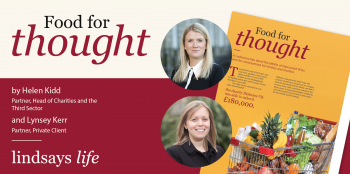According to the most recent data from charity legacy analysts, Legacy Foresight, legacy income for the participating charities rose by 12.5% in 2021. In terms of real figures, the sums donated increased from £1.44 billion in 2020 to £1.62 billion in 2021. The average legacy increased by around 6% to £63,800, with increasing house prices and favourable financial performances boosting charity receipts.
Other than the obvious benefit of providing well-deserved and often needed funds to charities, what are the benefits and considerations for high net worth (HNW) clients leaving funds to charity?
It is important for everyone to have a Will, whether you are a HNW client or not. Funds left in a Will to a registered charity are taken off the value of the estate before Inheritance Tax (IHT) is calculated. Over and above any allowances, IHT is charged at 40%. This can quickly wipe away a large amount of an estate over the allowances.
The two main allowances are the Nil Rate Band (NRB) – which is £325,000 and the residential Nil Rate Band – which is £175,000 (RNRB). Both these allowances can be rolled over and utilised on a second death but in order to claim any transferable allowances you must be married or in a civil partnership. In cases of a second death where the full allowances have been preserved there can be up to £650,000 of NRB and £350,000 of RNRB available.
It is worth explaining that the full £1 million total allowance is not always that easy to claim in full. In particular, the RNRB has various complexities. Three to note are:
- To claim the RNRB the testator must be leaving the interest in the property to a direct descendant which includes children, step–children and adopted children but not nieces and nephews for example. For someone without children it means the maximum allowance available is in fact £650,000 if married or in a civil partnership and their spouse/civil partner didn’t utilise any of their allowance.
- When a testator’s estate is over £2m in value, there is a taper applicable to the RNRB and it tapers off at £1 per £2 of the estate that is over £2m.
- If the property is worth less than the available RNRB you cannot offset the unused amount against other assets in the estate. The RNRB can only be used against one property in an estate and the testator must have occupied the property at some point in the past.
It can be beneficial for HNW clients who wish to mitigate or minimise their IHT bill on their estate to:
- Gift to charity in lifetime as these gifts will not use up any NRB if they then die within 7 years of the date of the gift as such lifetime gifts are exempt from IHT;
- Leave the residue of their estate over the allowances available to them to charity. This would result in no IHT becoming payable on their estate. Or if they wish to lower their IHT liability, leave some legacies to charity; or
- Leave 10% or more of their net estate to charity. This should result in the estate qualifying for a reduced rate of IHT of 36% on the chargeable portion of their estate. It is important for a Will to be drafted correctly to obtain this reduced rate of tax.
HNW clients provide charities with much needed funding and by doing so they can greatly reduce their IHT liability, in some cases to zero.






